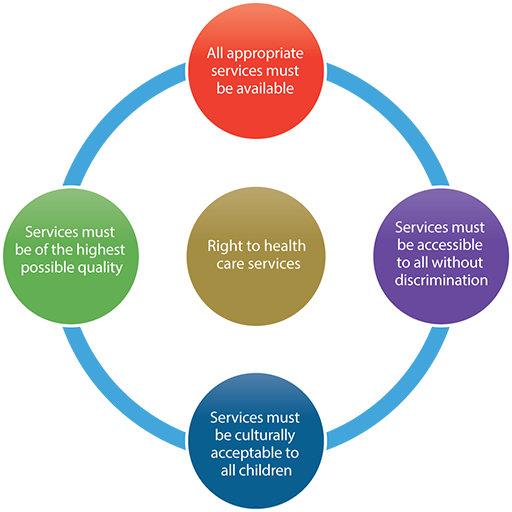At the level of health services
When providing health services, a rights-based approach to health needs to address the following inter-related elements illustrated in Figure 3.2. Each element is explored in more detail below.

Available
To achieve the right to health, services need to be available for every child, including those in the most inaccessible communities. There needs to be a sufficient number of hospitals, clinics, health practitioners, mobile teams and clinics where necessary, outreach services, equipment and essential drugs to provide health care to all children and mothers within the State.
Accessible
Health facilities, goods and services have to be accessible to every child who lives within the jurisdiction of the country. Accessibility has four dimensions:
- Non-discrimination: One important challenge is to ensure that health services are accessible to every child without discrimination, especially the most vulnerable or marginalised children in society.
- Physical accessibility: Health facilities, goods and services for children must be within safe physical reach, especially for those from vulnerable or marginalised groups. Particular challenges are faced by children living in hard to reach areas. For children with disabilities, accessibility of buildings and services is also essential.
- Affordability: Health facilities, goods and services must be affordable for all children. No child should be denied access to health care because of poverty.
- Information accessibility: Information on health promotion, health status and treatment options should be provided to children and their caregivers. This needs to be in a language and format that is accessible and clearly understandable to them, including for children with disabilities. Children, and especially adolescents, have the right to be adequately informed about sexual and reproductive health.
Acceptable
All health facilities, goods and services must be culturally appropriate. They need to take into account the cultural traditions of children from different ethnic or religious communities, and be sensitive to the specific needs of women and girls.
Quality
As well as being culturally acceptable, health facilities, goods and services need to be of a good quality. For example, staff must be properly trained and have appropriate experience and supervision. Facilities need to be properly equipped, safe, clean and hygienic. Drugs should never be used inappropriately or beyond their expiry date.
Activity 3.3: Health services and systems
Give examples of what your role might be when providing health services and systems for children.
Compare your answer with the one given at the end of the study session.
At the level of the individual child
